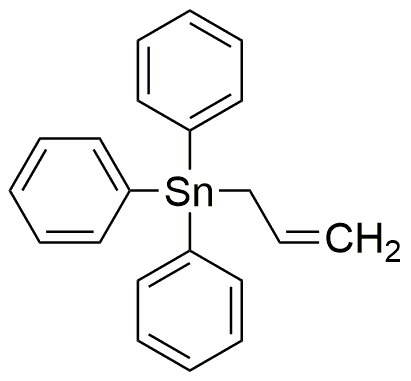Allyltriphenyltin is widely utilized in research focused on:
- Organic Synthesis: This compound serves as a versatile reagent in organic chemistry, enabling the formation of carbon-carbon bonds through various coupling reactions. Its unique structure allows for selective reactivity, making it invaluable for synthesizing complex organic molecules.
- Agricultural Applications: In the agricultural sector, it is used as a biocide and fungicide. Its effectiveness against a range of pests and fungi helps improve crop yields while minimizing the need for harsher chemicals.
- Polymer Chemistry: Allyltriphenyltin acts as a stabilizer in the production of polymers. Its incorporation can enhance the thermal stability and mechanical properties of materials, making it beneficial for industries focused on high-performance plastics.
- Biomedical Research: This compound is explored for its potential in drug delivery systems. Its ability to form stable complexes with various biomolecules can lead to more effective therapeutic agents, particularly in cancer treatment.
- Electronics Manufacturing: In the electronics industry, it is used in the production of organotin compounds that serve as intermediates for creating conductive materials. This application is crucial for developing advanced electronic devices with improved performance.
General Information
Properties
Safety and Regulations
Applications
Allyltriphenyltin is widely utilized in research focused on:
- Organic Synthesis: This compound serves as a versatile reagent in organic chemistry, enabling the formation of carbon-carbon bonds through various coupling reactions. Its unique structure allows for selective reactivity, making it invaluable for synthesizing complex organic molecules.
- Agricultural Applications: In the agricultural sector, it is used as a biocide and fungicide. Its effectiveness against a range of pests and fungi helps improve crop yields while minimizing the need for harsher chemicals.
- Polymer Chemistry: Allyltriphenyltin acts as a stabilizer in the production of polymers. Its incorporation can enhance the thermal stability and mechanical properties of materials, making it beneficial for industries focused on high-performance plastics.
- Biomedical Research: This compound is explored for its potential in drug delivery systems. Its ability to form stable complexes with various biomolecules can lead to more effective therapeutic agents, particularly in cancer treatment.
- Electronics Manufacturing: In the electronics industry, it is used in the production of organotin compounds that serve as intermediates for creating conductive materials. This application is crucial for developing advanced electronic devices with improved performance.
Documents
Safety Data Sheets (SDS)
The SDS provides comprehensive safety information on handling, storage, and disposal of the product.
Product Specification (PS)
The PS provides a comprehensive breakdown of the product’s properties, including chemical composition, physical state, purity, and storage requirements. It also details acceptable quality ranges and the product's intended applications.
Certificates of Analysis (COA)
Search for Certificates of Analysis (COA) by entering the products Lot Number. Lot and Batch Numbers can be found on a product’s label following the words ‘Lot’ or ‘Batch’.
Numéro de catalogue
Numéro de lot/série
Certificates Of Origin (COO)
This COO confirms the country where the product was manufactured, and also details the materials and components used in it and whether it is derived from natural, synthetic, or other specific sources. This certificate may be required for customs, trade, and regulatory compliance.
Numéro de catalogue
Numéro de lot/série
Safety Data Sheets (SDS)
The SDS provides comprehensive safety information on handling, storage, and disposal of the product.
DownloadProduct Specification (PS)
The PS provides a comprehensive breakdown of the product’s properties, including chemical composition, physical state, purity, and storage requirements. It also details acceptable quality ranges and the product's intended applications.
DownloadCertificates of Analysis (COA)
Search for Certificates of Analysis (COA) by entering the products Lot Number. Lot and Batch Numbers can be found on a product’s label following the words ‘Lot’ or ‘Batch’.
Numéro de catalogue
Numéro de lot/série
Certificates Of Origin (COO)
This COO confirms the country where the product was manufactured, and also details the materials and components used in it and whether it is derived from natural, synthetic, or other specific sources. This certificate may be required for customs, trade, and regulatory compliance.


